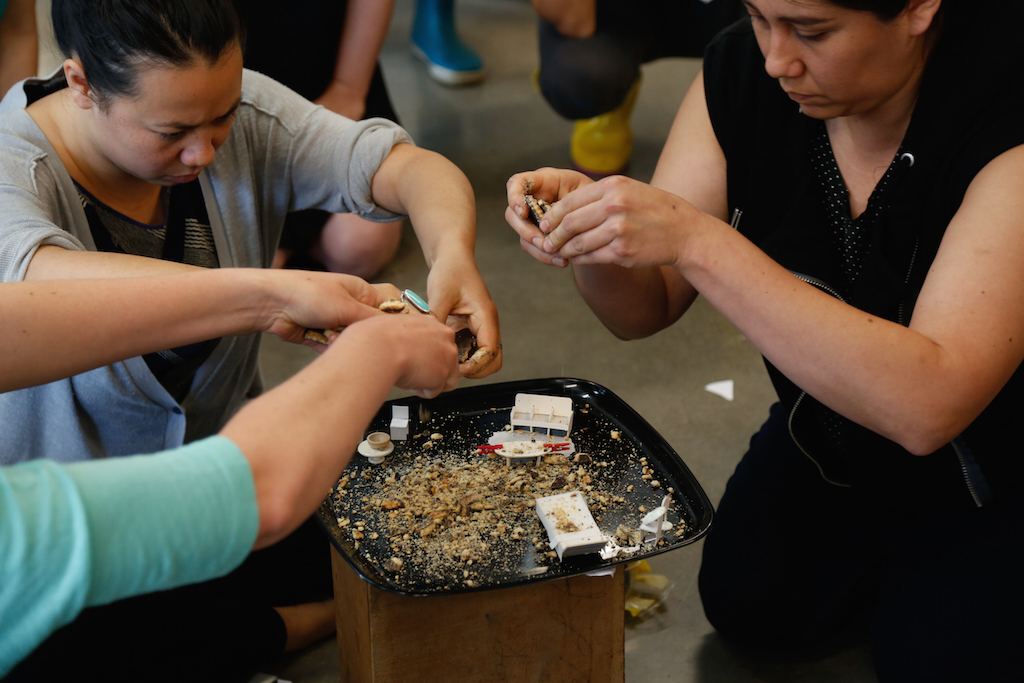Train of Thought, an artistic journey across Canada consisting of Indigenous and non-Indigenous voices, pulled into Toronto last week.
On Wednesday, I found myself sitting cross-legged in Ange Loft’s workshop — described as ‘quick theatre creation using audio’ in the program.
I had my brown sheet of paper in front of me and my blue oil pastel in hand, ready to be inspired by the interview with Lee Maracle playing on the speakers.
The interviewer asked Maracle how she felt about treaties.
“It’s sort of like this,” Maracle begins. “You had a house, and the neighbour moves into your house. Pretty soon he kicks you out. It’s still your house, and you will always believe it’s your house.”
Pastels fly to papers around the room. Some scrawl words from the interview; others outline them in block letters. Still others draw houses, trees and rivers.
“You can’t just come into somebody’s house and take all their shit and throw them out and expect them to agree with you… and then give them a candy bar and say ‘this is your treaty payment.’ It doesn’t work that way,” Maracle’s recorded interview continues.
Next, Loft breaks the 24 participants into small groups to great multi-platform art based on their takeaway from the audio. The workshop reminds me of drama class in school, but with heavier subject matter and more talented participants.
One group plays with the ‘candy bar’ analogy in their performance, crumbling cookies onto a tray with little paper furniture. Another re-appropriates the first line of O Canada, singing “O Canada, our stolen Native land,” in harmony. Yet another runs out onto Fort York Boulevard, singing and pouring water on the sidewalk — getting confused looks from Blue Jays fans.
My own group enacted a scene based on the 27 buried rivers beneath Toronto.
“I think there is so much history to feeling like you can just cover something up and pretend like it’s not there,” says MacKenzie Konecny, a visual artist with Jumblies Theatre, which is producing Train of Thought. “[it] feels really connected to the way we treat nature, the way we treat our water and how we treat people.”
Loft says she wants people to realize the kind of art they can create with just a few words and a spare half hour. This workshop is part of her larger Talking Treaties project.
“We talk about reconciliation and all these big words, but when it comes down to it you kind of have to know how to work together first. I feel like making art might be an easy way to at least to know what’s on another person’s mind,” she says.
She also says finding an easy way in to the subject matter, like the Maracle interview, is necessary.
“There has to be a way that we can make it approachable and understandable and relatable,” she says.
Train of Thought is a journey about art-making, relationship building and reconciliation between Indigenous and non-Indigenous peoples, says Nikki Shaffeeullah, another artist with Train of Thought.
She explains that even the train’s journey from Victoria to Prince Edward Island is counter-colonial.
“There is this sort of metaphorical of idea of how we can de-colonize the train by taking it west to east in a counter-colonial route,” she says.
Braiden Houle, another artist with Train of Thought, says the group stops to talk to community elders at each stop on the journey.
“They teach us a story and we take something away from that,” he says.
A set of musical and spoken word performances Wednesday night took a break for a brief lecture on the Indigenous peoples who have inhabited the area that is now Toronto.
The site of the city was once an important portage when traversing the great lakes. Moccasin footprints in the area have been dated at 11,000 years old.
Loft says Toronto has a lot going on when it comes to treaties. There are many in play, and their borders aren’t always clear.
“There’s this amazing thing called a walking treaty. It pretty much says your land goes as far as you could walk in a day. Accurate, right?” she says sarcastically.
On top of this, she says there’s the Dish with one Spoon treaty that extends all the way from Montreal to the middle of the United States.
“We want to get as many voices as we possibly can about treaties from as many people as we can so we have an understanding beyond the actual documents. We can kind of feel out what’s happening with treaties on the ground,” she says.
When it comes to her art, Loft says that getting one’s hands dirty is what’s really important.
“I always do this thing where if you’re in the room you’re in it. So that’s really how it goes,” she says.
Megan Devlin is rabble’s news intern for 2015. She hails from Toronto, but she’s starting her Masters in Journalism in Vancouver. She got her start in journalism working at the Western Gazette where she was a news editor for volume 107 and online associate editor for volume 108.



